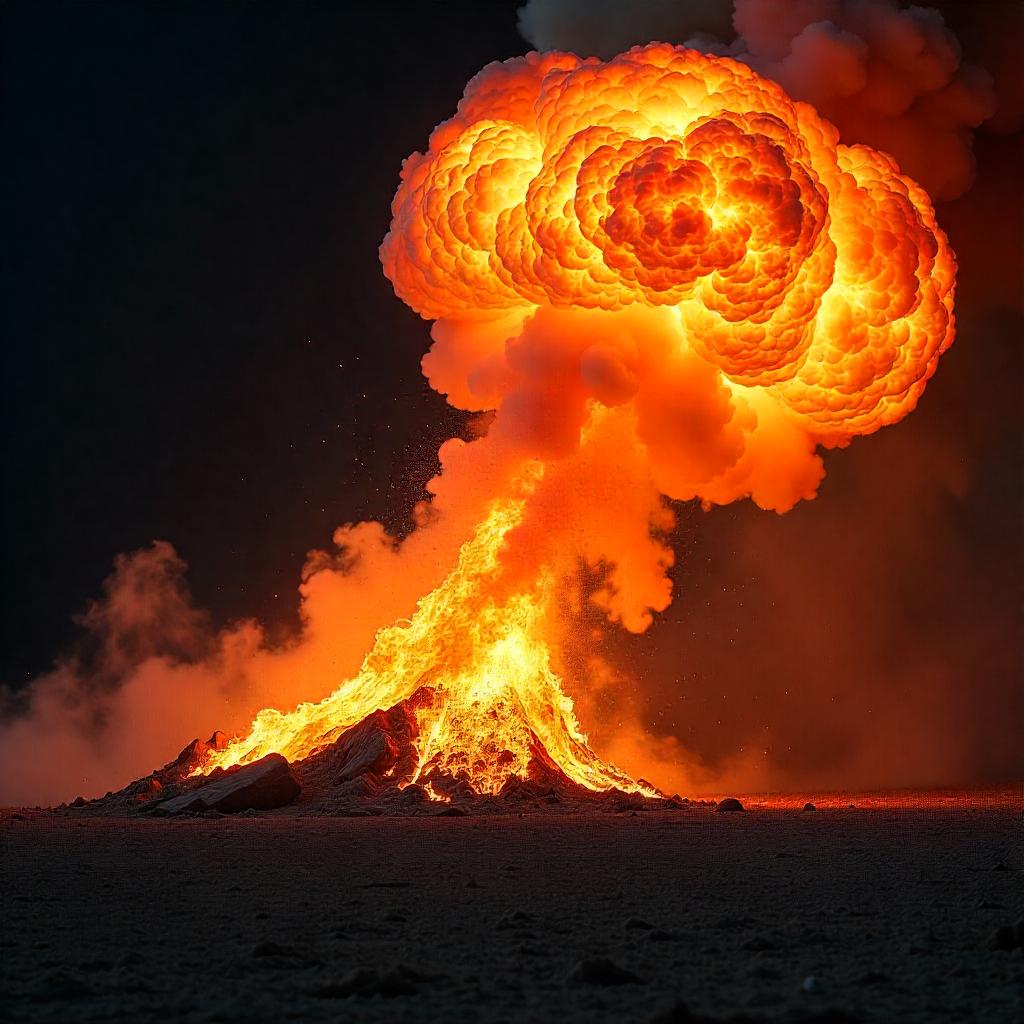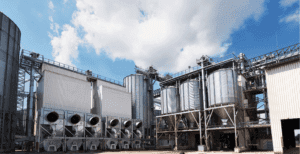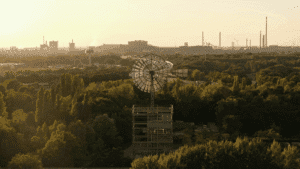Alüminyum Tozu Patlamaları Nedir?
Alüminyum tozu patlamaları, küçük alüminyum tozu parçacıklarının havayla karışıp yangın tehlikesi oluşturmasıyla meydana gelir. Bu patlamalar belirli koşullarda meydana gelebilir. Alüminyum tozu havada asılı kaldığında tutuşarak güçlü bir patlamaya neden olabilir. Bu durum, alüminyumun işlendiği fabrikalar gibi yerlerde çok tehlikeli olabilir.
Alüminyum tozu patlamaları hakkında bazı önemli noktalar şunlardır:
- Yanıcı Toz: Alüminyum tozu yanıcı toz olarak kabul edilir. Bu, doğru koşullar altında yanabileceği ve yangına neden olabileceği anlamına gelir.
- Havada Süspansiyon: Alüminyum tozu havada olduğunda bulut oluşturabilir. Bu bulut tutuşursa patlamaya yol açabilir.
- Ateşleme KaynaklarıYaygın ateşleme kaynakları arasında kıvılcımlar, alevler veya ısı bulunur. Küçük kıvılcımlar bile patlamaya neden olabilir.
- Toz Birikimi: Yüzeylerde toz birikmesi riski artırabilir. Biriken toz daha kolay tutuşabilir.
- Kapalı Alanlar: Kapalı alanlarda patlama olasılığı daha yüksektir. Kapalı bir alan toz ve havayı hapsederek tehlikeli bir durum yaratabilir.
Bu noktaların anlaşılması, alüminyum tozu patlamalarının önlenmesine ve işyerlerinin güvenli tutulmasına yardımcı olabilir.
Alüminyum Tozu Patlamalarının Nedenleri
Alüminyum tozu patlamaları birkaç temel nedenden dolayı meydana gelebilir. Bu nedenleri anlamak güvenlik açısından önemlidir.
- İnce Alüminyum Parçacıklarının Birikimi: Küçük alüminyum parçacıkları bir yerde toplandığında toz bulutu oluşturabilir. Bu bulut çok tehlikeli olabilir. Toz yeterince birikirse patlamaya yol açabilir.
- Ateşleme Kaynakları: Tutuşturma kaynakları, yangını başlatabilecek şeylerdir. Yaygın tutuşturma kaynakları arasında kıvılcımlar, alevler ve hatta sıcak yüzeyler bulunur. Bu kaynaklar alüminyum tozuyla temas ederse patlamaya neden olabilir.
- Oksijenin varlığı: Yangın için oksijen gereklidir. Alüminyum tozunun bulunduğu bir ortamda, yeterli oksijen varsa yangın çıkabilir. Bu durum, alüminyum tozu tutuştuğunda patlama riskini artırır.
Bu sebepleri bilmek, insanların kazaları önlemek için adımlar atmasını sağlar.
Alüminyum Tozu Patlamalarına İlişkin Önemli Vaka Çalışmaları
Alüminyum tozu patlamalarına dair dikkat çekici vaka çalışmaları, bu malzemenin ne kadar tehlikeli olabileceğini göstermektedir. 2003 yılında Indiana, Huntington'daki Hayes Lemmerz International'da büyük bir olay meydana geldi. Bu patlama ciddi hasar ve kayıplara yol açtı.
Hayes Lemmerz'de işçiler üretim süreçlerinde alüminyum kullandılar. Çok fazla alüminyum tozu ürettiler. Bu toz çok kolay alev alabilir. Bu durumda, bir kıvılcım tozu tutuşturdu. Patlama binayı sarstı ve kaosa neden oldu. Ne yazık ki, bazı işçiler yaralandı ve önemli miktarda maddi hasar meydana geldi.
Patlama herkese önemli dersler verdi. İlk olarak, işyerlerinde tozu kontrol altına almanın ne kadar önemli olduğunu gösterdi. Şirketler düzenli olarak toz temizliği yapmalıdır. İkinci olarak, uygun güvenlik eğitimine duyulan ihtiyacı vurguladı. Çalışanlar yangın çıktığında ne yapmaları gerektiğini bilmelidir. Son olarak, herkese güvenlik ekipmanlarını hazır bulundurmaları gerektiğini hatırlattı. Yangın söndürücüler ve toz toplama sistemleri bu tür felaketlerin önlenmesine yardımcı olabilir.
Hayes Lemmerz patlamasından çıkarılacak en önemli sonuçlar şunlardır:
- Alüminyum tozu oldukça yanıcıdır ve patlamalara sebep olabilir.
- Düzenli temizlik toz birikmesini önleyebilir.
- Güvenlik eğitimi tüm çalışanlar için olmazsa olmazdır.
- Elinizin altında güvenlik ekipmanlarının bulunması hayat kurtarabilir.
Önleyici Tedbirler ve En İyi Uygulamalar
Alüminyum tozu patlamalarını önlemek için önleyici tedbirler ve en iyi uygulamalar önemlidir. Alüminyum tozu oldukça yanıcıdır. Doğru adımları izlemek herkesin güvenliğini sağlayabilir.
- Uygun Toz Toplama KullanınAlüminyum tozunu toplamak için toz toplama sistemleri kurun. Bu sistemler, toz üreten makinelerin yakınına yerleştirilmelidir. Havadaki tozu azaltmak için sistemlerin iyi çalıştığından emin olun.
- Düzenli Bakım: Makineleri sık sık kontrol edin ve temizleyin. Bu, biriken alüminyum tozunu gidermeye yardımcı olur. Toz toplama sistemlerini temiz ve iyi durumda tutun. Her şeyin düzgün çalıştığından emin olmak için düzenli bakım kontrolleri planlayın.
- Çalışan Eğitimi: Çalışanları alüminyum tozunun tehlikeleri konusunda eğitin. Toz toplama sistemlerini nasıl kullanacaklarını öğretin. Çalışma alanlarını temiz ve güvenli tutmanın önemini anlamalarını sağlayın.
- Güvenli Çalışma Uygulamalarını Uygulayın: Alüminyum tozuyla başa çıkmak için kurallar oluşturun. Çalışanları dökülenleri derhal temizlemeye teşvik edin. Yeni işlere başlamadan önce tüm tozun temizlendiğinden emin olun.
- Hava Kalitesini İzleyin: İşyerindeki havayı düzenli olarak test edin. Bu, güvenli olmayan seviyelerde alüminyum tozu olup olmadığını kontrol etmenize yardımcı olur. Seviyeler yüksekse, havalandırmayı iyileştirmek veya toz toplamayı artırmak için önlem alın.
- Uygun Depolamayı Kullanın: Alüminyumu güvenli bir şekilde saklayın. Tozun dışarı çıkmasını önlemek için kapalı kaplar kullanın. Saklama alanlarının temiz ve düzenli olduğundan emin olun.
- Patlama Koruma Ekipmanını Kurun: Patlamaları önlemek için tasarlanmış ekipmanları kullanmayı düşünün. Bunlara patlama menfezleri ve söndürme sistemleri de dahildir. Bu araçlar, iş yerinin güvenliğini sağlamaya yardımcı olabilir.
Şirketler bu adımları izleyerek alüminyum tozu patlama riskini azaltabilir ve çalışanların güvenliğini sağlayabilirler.
Patlama Önlemede Filtrasyon Sistemlerinin Rolü
Patlama önlemede filtreleme sistemlerinin rolü çok önemlidir. Intensiv Filter Himenviro gibi gelişmiş filtreleme sistemleri, çalışma alanlarının güvenli kalmasına yardımcı olur. Bu sistemler, endüstriyel ortamlardaki alüminyum tozunu etkili bir şekilde giderebilir. Alüminyum tozu biriktiğinde patlamalara neden olabilir.
Filtreleme sistemleri, toz parçacıklarını tutarak çalışır. Havadaki zararlı maddeleri filtrelerler. Bu, havayı temiz tutar ve yangın ve patlama riskini azaltır. Alüminyum tozunun giderilmesi, fabrikalarda ve diğer endüstriyel alanlarda güvenliği sağlamanın önemli bir adımıdır.
İşte farklı filtrasyon sistemlerinin karşılaştırması:
| Filtrasyon Sistemi | Özellikler | Faydalar |
| Yoğun Filtre Himenviro | Yüksek verimli filtre ortamı | .9% alüminyum tozunu giderir |
| Standart Filtre | Temel toz giderme | Düşük riskli ortamlar için iyi |
| HEPA Filtresi | Yüksek verimli partikül hava | Küçük parçacıkları yakalar |
| Elektrostatik Filtre | Tozu yakalamak için elektrik yükü kullanır | İnce tozlar için etkilidir |
Her filtreleme sisteminin kendine özgü güçlü yanları vardır. Intensiv Filter Himenviro, neredeyse tüm alüminyum tozlarını giderebilme özelliğiyle öne çıkar. Bu, onu bu tür malzemelerle çalışan endüstriler için mükemmel bir seçim haline getirir. Çevrenin temiz tutulması, tehlikeli durumların önlenmesine yardımcı olur.
Düzenleyici Standartlar ve Uyumluluk
Alüminyum gibi yanıcı tozlarla çalışırken düzenleyici standartlar ve uyumluluk önemlidir. Bu standartlar, çalışanların güvenliğini sağlamaya ve kazaları önlemeye yardımcı olur. Bu standartları belirleyen iki önemli kuruluş vardır: OSHA ve NFPA.
- OSHA, İş Sağlığı ve Güvenliği İdaresi'nin kısaltmasıdır. OSHA, çalışanları tehlikeli durumlardan korumak için kurallar oluşturur. Yanıcı tozla başa çıkmak için özel yönergeleri vardır.
- NFPA, Ulusal Yangın Koruma Derneği'nin kısaltmasıdır. NFPA, yanıcı tozlardan kaynaklanan yangın ve patlamaları önlemek için standartlar oluşturur. Ortamları güvenli tutmak için tozun nasıl yönetileceğine odaklanırlar.
- OSHA, işverenlerin işyerlerindeki yanıcı toz risklerini değerlendirmelerini ve bu riskleri azaltmak için planlar oluşturmalarını zorunlu kılmaktadır.
- NFPA, toz tehlikelerini en aza indirmek için bina ve sistemlerin nasıl tasarlanacağına dair yönergeler sunar. Havalandırma ve toz toplama konusunda önerilerde bulunur.
- Hem OSHA hem de NFPA, çalışanların eğitilmesinin önemini vurgulamaktadır. Çalışanların yanıcı toz risklerini ve güvenli çalışma yöntemlerini anlamaları gerekmektedir.
- Bu düzenlemelere uyum sağlamak çok önemlidir. Şirketler, para cezalarından kaçınmak ve güvenli bir çalışma ortamı sağlamak için bu standartlara uymalıdır.
- Düzenli denetimler ve teftişler, şirketlerin OSHA ve NFPA standartlarına uymasını sağlar. Bu, çalışanları olası tehlikelerden korur.
Bu düzenlemelere uyulması kazaların önlenmesine yardımcı olur ve işyerindeki herkesi korur.
Toz Patlama Önlemede Yenilikler
Toz patlaması önleme alanındaki yenilikler, insanların güvenliğini sağlamaya yardımcı olan yeni teknolojilere odaklanmaktadır. Son gelişmeler arasında otomatik izleme sistemleri ve patlama bastırma teknolojileri yer almaktadır. Bu araçlar, çeşitli endüstrilerde toz patlaması riskini azaltmak için birlikte çalışır.
Otomatik izleme sistemleri, tehlikeli toz seviyelerini izler. Havadaki toz parçacıklarını tespit etmek için sensörler kullanırlar. Toz seviyeleri çok yükseldiğinde, bu sistemler çalışanlara uyarı gönderir. Bu, bir patlama meydana gelmeden önce harekete geçmelerine yardımcı olur.
Patlama bastırma teknolojileri, patlamalar başladıktan sonra onları durdurmaya yardımcı olur. Bu sistemler, yangını soğutan özel kimyasallar salgılar. Ayrıca patlamanın yarattığı basıncı da azaltırlar. Bu, hayat kurtarabilir ve ekipmanları koruyabilir.
Toz patlamasının önlenmesindeki temel gelişmeler şunlardır:
- Gerçek zamanlı izleme: Sistemler toz seviyelerini sürekli olarak kontrol edebilir.
- Veri analizi:Gelişmiş yazılımlar tehlikeli durumları önceden tahmin edebilir.
- Otomatik uyarılar: Çalışanlara anında bildirimler gönderilir.
- Kimyasal baskılama: Özel ajanlar yangınları hızla kontrol altına alabilir.
- Basınç tahliye sistemleri: Bunlar patlamanın etkisini azaltır.
Bu yenilikler, endüstrilerin güvenli bir şekilde faaliyet göstermesine yardımcı olur. Çalışanlar için daha güvenli bir ortam yaratır ve önemli ekipmanları korur. Bu teknolojilerin kullanımı kazaları önleyebilir ve hayat kurtarabilir.
Çözüm
Alüminyum tozu patlamaları, alüminyum işleyen endüstrilerde önemli bir risk oluşturmaktadır. Bu patlamalar, ince alüminyum parçacıklarının havayla karışması ve kıvılcım, ısı veya alev gibi yaygın kaynaklar tarafından tutuşturulması sonucu meydana gelir. Toz birikimi ve oksijenin varlığı gibi nedenlerin anlaşılması, kazaları önlemek için çok önemlidir. Hayes Lemmerz patlaması gibi önemli vaka çalışmaları, düzenli toz kontrolünün, uygun güvenlik ekipmanının ve çalışan eğitiminin önemini vurgulamaktadır.
Verimli toz toplama sistemlerinin kullanımı, düzenli bakım, çalışan eğitimi ve patlamaya karşı koruma ekipmanlarının uygulanması gibi önleyici tedbirler, alüminyum tozu patlama riskini büyük ölçüde azaltabilir. Özellikle Intensiv Filter Himenviro gibi gelişmiş tedarikçilerin sunduğu filtreleme sistemleri, alüminyum tozunu hapsetmede ve güvenli çalışma ortamları sağlamada hayati bir rol oynar.


